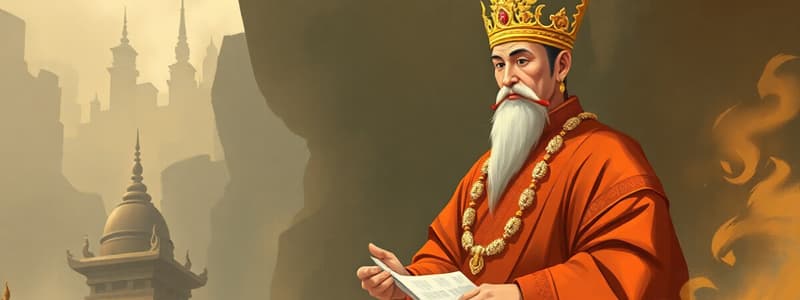Podcast
Questions and Answers
What was the primary reason King Mongkut initiated diplomatic relations and reforms in Siam during the second stage of imperialism?
What was the primary reason King Mongkut initiated diplomatic relations and reforms in Siam during the second stage of imperialism?
- To gain military support from Western nations against neighboring kingdoms.
- To prevent Western powers from forcefully entering and conquering Siam through diplomacy and modernization. (correct)
- To convert Siam into a Western-style democracy and integrate it into the European political system.
- To secure financial loans from Western powers to fund infrastructure projects.
The Bowring Treaty of 1855 between Siam and Britain stipulated that British citizens would not be tried in Siamese courts without Britain's consent. What is this an example of?
The Bowring Treaty of 1855 between Siam and Britain stipulated that British citizens would not be tried in Siamese courts without Britain's consent. What is this an example of?
- International Mandate
- Diplomatic Immunity
- Extraterritoriality (correct)
- Sovereign Immunity
What role did Thailand (Siam) play in the imperialistic strategies of Britain and France in Southeast Asia?
What role did Thailand (Siam) play in the imperialistic strategies of Britain and France in Southeast Asia?
- It was divided into zones of influence, with Britain and France administering different regions.
- It became a major source of raw materials and cheap labor for European industries.
- It served as a military base for both Britain and France to launch further conquests.
- It acted as a buffer state, preventing clashes between British and French interests in the region. (correct)
Which of the following best describes King Chulalongkorn's primary focus in his reforms, contrasting with his father, King Mongkut?
Which of the following best describes King Chulalongkorn's primary focus in his reforms, contrasting with his father, King Mongkut?
How did King Mongkut strategically use education to maintain Siam's independence during the age of imperialism?
How did King Mongkut strategically use education to maintain Siam's independence during the age of imperialism?
What was the most significant long-term consequence of the reforms initiated by King Mongkut and King Chulalongkorn?
What was the most significant long-term consequence of the reforms initiated by King Mongkut and King Chulalongkorn?
Why did some of King Narai's generals drive the British and French out of Siam in the 16th century?
Why did some of King Narai's generals drive the British and French out of Siam in the 16th century?
Besides Britain, which other Western power did Siam enter into a similar agreement with following the Bowring Treaty?
Besides Britain, which other Western power did Siam enter into a similar agreement with following the Bowring Treaty?
What specific action taken by King Chulalongkorn aimed to weaken the aristocracy's established power in Siam?
What specific action taken by King Chulalongkorn aimed to weaken the aristocracy's established power in Siam?
Who was Anna Leonowens, and what role did she play in the modernization of Siam?
Who was Anna Leonowens, and what role did she play in the modernization of Siam?
Flashcards
Bowring Treaty
Bowring Treaty
The treaty signed between Siam (Thailand) and Britain in 1855, opening Siam to trade, reducing taxes, allowing British land ownership, and establishing a consulate in Bangkok.
Extraterritoriality in Siam
Extraterritoriality in Siam
The principle that British citizens in Siam could only be tried with Britain’s consent, not under Siamese law.
King Mongkut
King Mongkut
King of Siam who welcomed foreigners through diplomacy and reforms to modernize the kingdom and prevent conquest.
King Chulalongkorn (Rama V)
King Chulalongkorn (Rama V)
Signup and view all the flashcards
Buffer State
Buffer State
Signup and view all the flashcards
Anna Leonowens
Anna Leonowens
Signup and view all the flashcards
Thailand (Siam)
Thailand (Siam)
Signup and view all the flashcards
Mongkut's Strategy
Mongkut's Strategy
Signup and view all the flashcards
Study Notes
- Thailand, formerly known as Siam, maintained its independence during the era of colonialism and imperialism in Southeast Asia.
Thailand in the First Stage of Imperialism
- In 1511, the Thais allowed the Portuguese to engage in trade through a treaty.
- The Siamese royal class and Buddhist monks disapproved of King Narai's close ties with foreigners.
- Following King Narai's illness, his generals seized power and expelled the British and French but allowed the Dutch to continue trading.
Thailand in the Second Stage of Imperialism
- King Mongkut believed that isolating Siam from Westerners would intensify their efforts to conquer the kingdom.
- Through diplomacy and negotiations, King Mongkut welcomed foreigners into Siam.
- The Bowring Treaty was signed in 1855 between Siam and Britain, which opened the kingdom to trade and reduced Siam's tax on merchandise.
- The British were permitted to own land in Siam and establish a consulate in Bangkok, which was the kingdom’s new capital.
- The treaty granted the British extraterritoriality in Siam, meaning they could not be tried in Siamese courts without Britain's consent.
- Britain guaranteed Siam's independence and pledged non-interference from Western countries.
- Siam entered into a similar agreement with France the following year, which allowed France to trade, run a religious mission, and send warships to Bangkok.
- King Mongkut aimed to prevent conquest by presenting Siam as equal to Western powers in prosperity and culture, leading to various reforms.
- King Mongkut introduced coinage as a new monetary system and expanded ports and warehouses.
- King Mongkut improved infrastructure by building more roads and telegraph lines.
- Royal children, government officials, and the royal class were encouraged to pursue Western education to effectively interact with foreigners.
- Anna Leonowens, an English teacher, tutored King Mongkut's children and wives, inspiring the novel, film, and musical "Anna and the King."
- King Chulalongkorn o Rama V, King Mongkut's son, succeeded him in 1886.
- King Chulalongkorn focused on political and social reforms, unlike his father's emphasis on cultural reforms.
- King Chulalongkorn formed a council of advisers and established a centralized tax collection system
- These reforms weakened the aristocracy, which previously controlled these systems.
- In 1905, King Chulalongkorn abolished forced labor and slavery in Siam, following the example of Western countries.
- Like his father, King Chulalongkorn prioritized Western education and sent Thai children from royal families to study in Europe and America, so they could help modernize Thailand.
Summary
- King Mongkut and King Chulalongkorn used diplomacy and reform to avoid conquest by Westerners.
- They opened Siam to trade and foreign interests and used Western influences modernize Thailand’s culture, politics, economy, and society.
- France and Britain guaranteed Siam's independence, as it served as a buffer state to prevent conflict between their interests.
Studying That Suits You
Use AI to generate personalized quizzes and flashcards to suit your learning preferences.




